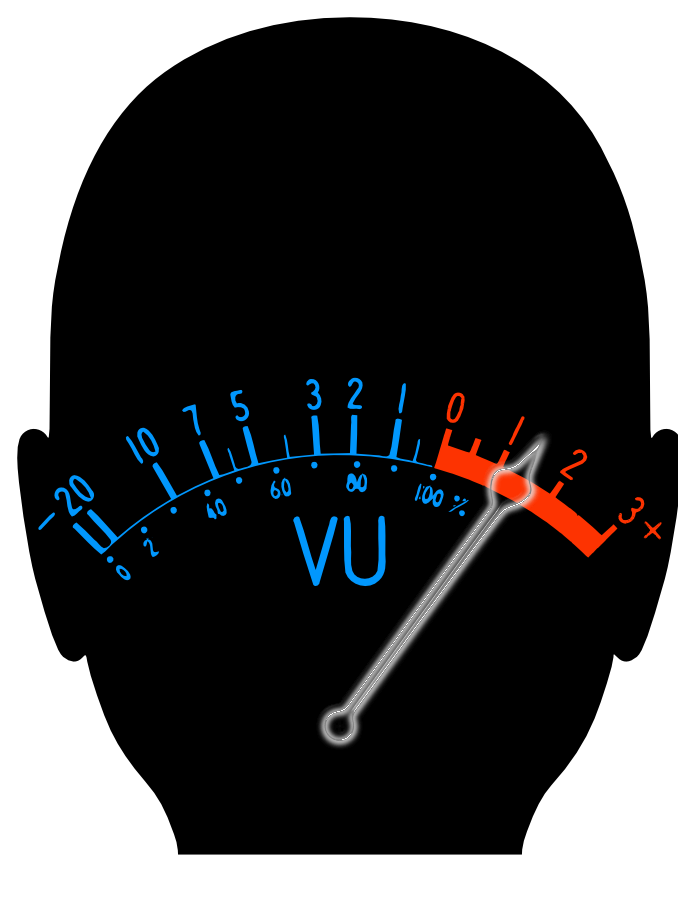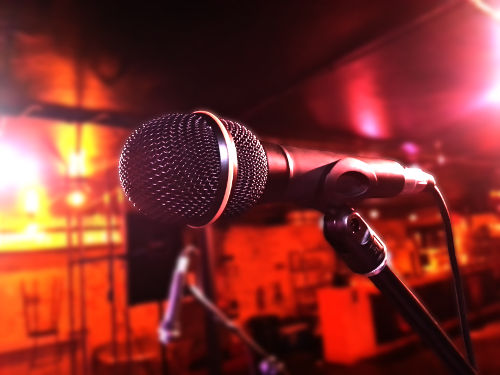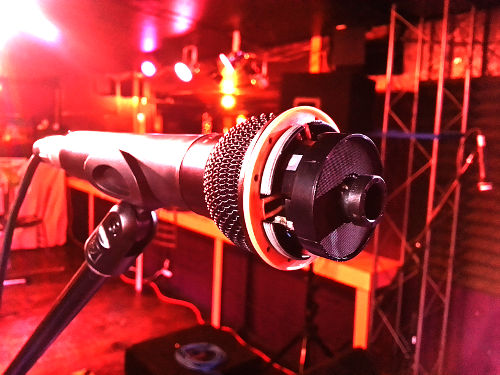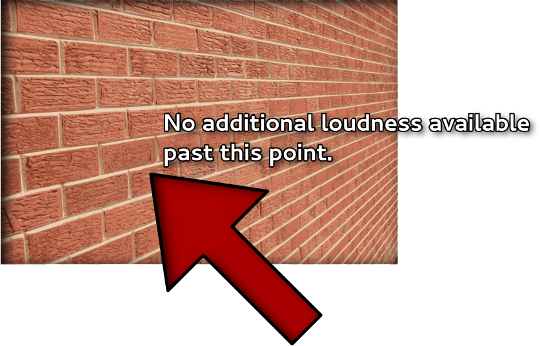If you have zero headroom anywhere, you have zero headroom everywhere.
Please Remember:
The opinions expressed are mine only. These opinions do not necessarily reflect anybody else’s opinions. I do not own, operate, manage, or represent any band, venue, or company that I talk about, unless explicitly noted.


“Headroom” is a beloved buzzword for audio craftspersons. Part of the reason it’s beloved is because you can blame your problems on the lack of it:
“I hate those mic pres. They don’t have enough headroom.”
“I’m always running out of headroom on that console’s mix buses.”
“I need to buy a more powerful amplifier for my subs, because I this one doesn’t have enough headroom.”
(I’m kinda tipping my hand a bit with that last one, in terms of this post being sort of a “follow on” to my article about clipping.)
Headroom is sometimes treated as a nebulous sort of concept – a hazy property that really good gear has enough of, and not-so-good gear doesn’t possess in the required quantity. In my opinion, though, headroom is pretty easy to define, and its seeming mysteriousness is due to it being used as a “blamecatcher” for things that didn’t go as planned.
Headroom, as I was taught, is “the difference between the maximum attainable level and the nominal level.” In other words, if a device can pass a signal of greater intensity than is required for a certain situation, then the device has some non-zero amount of headroom. For example, if your application requires a console’s main bus to pass 0 dBu (decibels referenced to 0.775 volts, RMS), and the console can pass +24 dBu, then you have 24 dB of headroom in the console.
(If it’s available, and ya ain’t usin’ it, it’s headroom.)
The overall concept is pretty easy to understand, but what a good number of folks aren’t taught, and often fail to realize for a good long while (this includes me), is that headroom is holistic, and “lowest common denominator.” That is to say:
Two or more audio components – whether electrical or acoustical – connected together all have the SAME effective headroom, and that effective headroom is equal to the LOWEST amount of headroom available at any point in the signal chain.
So…what the heck does that mean?
Everything Has A Maximum Level – Everything
To start with, it’s important to point out that hyphenated bit in the above definition. Especially because this is a site about live-performance, what you have to realize is that absolutely everything connected to that live performance has a maximum amount of appropriate signal intensity. Even acoustical sources and your audience qualify for this. Think about it:
A singer can’t sing any louder than they can sing.
A mic can only handle so much SPL.
A preamp can only swing a limited amount of voltage at its outputs.
Different parts of a console’s internal signal path have limits on how much signal they can handle.
A power amplifier can’t deliver an infinite amount of voltage.
Speakers handle a limited amount of power.
The people listening to the show have a finite tolerance for sound pressure.
…and every single one of these “components” is connected to the others. Sure, the connection may not be a direct, electrical hookup, but the influences of other parts of the system are still felt. If your system can create a “full tilt boogie” sound pressure level of 125 dB SPL C, but your audience will only tolerate about 105, then that lower level becomes your “don’t exceed” point. Go beyond it, and you effectively “clip” the audience…which makes your 20 dB of unused PA capability partially irrelevant. That leads to my next point.
Your Minimum Actual Headroom Is All You Effectively Have
Sometimes, a singer will “run out of gas.” They may have strained themselves, or they might not be feeling well, or they might just be tired. As a result, their maximum acoustical output drops by some amount.
Here’s the thing.
The entire system’s EFFECTIVE headroom has just dropped by that amount. If the singer is 10 dB quieter than they used to be, you’ve just lost 10 dB of effective headroom.
Now – before you start getting bent out of shape, complaining that your console’s mix bus headroom hasn’t magically changed, look at that paragraph again. The key is the word “effective.”
Of course your console can still pass its maximum signal. Of course your loudspeakers still handle the same power as they did a moment ago. As isolated components, their absolute headroom has not changed in any way.
But components working in a complete electro-acoustical system are not isolated, and are therefore limited by each other in various ways.
In the case of a singer getting worn out, their vocal “signal” drops closer to the noisefloor of the band playing around them. Now, if we were talking about an electrical device, the noisefloor staying the same with a decrease in maximum level above that noisefloor would be – what? Yes: A loss of headroom.
The way this affects everything else is that you now have to drive the vocal harder to get a similar mix. (It’s not the same mix, because there’s less acoustical separation between the singer and the band at the point of the mic capsule, but that’s a different discussion.) Because the singer’s overall level has dropped, your gain change might not be pushing you any closer to clipping an electrical device…but you are definitely closer to the point where your system will “ring” with feedback. A system in feedback, effectively, has reached its maximum available output.
Your effective headroom has dropped.
A Bigger Power Amp Isn’t Enough
Okay – here’s the bit that’s directly related to my “clipping” article.
The concept of holistic headroom is one of the larger and fiercer bugaboos to be found in the piecing together of live-audio rigs. As many bugaboos do, it grows to a fearsome size by feeding on misconceptions and mythology. There is a particular sub-species of this creature that’s both common and venomous: The idea that a system headroom problem can be fixed by purchasing more powerful amplifiers.
Now, if you’re constantly clipping your amps because the system won’t get loud enough for your application, then yes, you need to do something about the problem. However, what you need to do has to be effective on the whole, and not just for one isolated part of the signal chain. Buying a bigger amplifier will probably get you some headroom at the amplifier, but it might not actually get you any more effective headroom (which is what actually matters). If your old amplifier’s maximum level was equal to your speakers’ power handling, and the new amplifier is more powerful than the old one, then you’ve done nothing in terms of effective headroom.
The loudspeakers were already hitting their maximum level. As such, they had zero headroom, and your new amp is thus effectively limited to zero additional headroom. Your enormously powerful amp is doing virtually nothing for you, except for letting you hit your unchanged maximum level without seeing clip lights.
To be fair, the system will get somewhat louder because loudspeakers don’t “brickwall” at their maximum input levels. Also, the nature of most music is that the peaks are significantly higher than the continuous level, which lets you get away with a too-big amp for a while. You will get some more level for a while, but your speakers will die much sooner than they should – and when they do, your system will become rather quieter…
Anyway.
The point is that, if you want a system headroom increase of “x” decibels, then you have to be sure that every part of your system – not just one piece – has “x” more decibels to give you. If you’re going to get more power, you have to make sure that you also have that much more “speaker” to receive that power. (And this gets into all kinds of funny business, like whether or not you can buy speakers that are just as efficient as what you’ve had while handling more power, or whether you need to buy more of the same speakers, and if that’s a good idea because of arrayability, or…)
There’s also the question of whether or not a more powerful system is what your audience even wants. It all ties together, because headroom is holistic.






